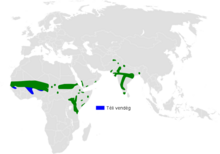Bush lark
| Bush lark | ||||||||||||
|---|---|---|---|---|---|---|---|---|---|---|---|---|

Bush Lark ( Mirafra cantillans ) |
||||||||||||
| Systematics | ||||||||||||
|
||||||||||||
| Scientific name | ||||||||||||
| Mirafra cantillans | ||||||||||||
| Blyth , 1845 |
The bush lark ( Mirafra cantillans ) is a species from the lark family. Their distribution area extends from West Africa to India. Several subspecies are distinguished in the large distribution area.
features
The bush lark reaches a body length of 12.5 to 15.0 centimeters, of which 4.5 to 5.5 centimeters are on the tail. It weighs about 20 grams. There is no noticeable gender dimorphism .
The top of the bush lark is reddish, reddish-gray to black-brown or sand-colored, depending on the subspecies. The wings are lined with light. The underside of the body is light reddish to beige, the chest is speckled with dark brown. The tail is brown. The bill is yellowish horn-colored to brown, the feet are light flesh-colored to brownish flesh-colored depending on the subspecies. The iris is brown.
The typical lark song, which consists of a series of variable phrases, is performed from the ground or in flight. The bush lark is one of the species of lark that imitates other species of birds - over a dozen imitations of the songs of other species of birds have been found in them.
Possible confusion
The white-tailed lark ( Mirafra albicauda ), which occurs in parts of the bush lark's distribution area, has similarities with the bush lark. The white-tailed lark differs from this one by the darker upper side of the body and the two outer white tail feathers. The song of the bush lark also has trills that are missing in the white-tailed lark. The white-tailed lark also only walks a few steps, unlike the bush lark, after it has dropped back to earth from its song flight. The Friedmann Lark ( Mirafra pulpa ) is similar to the Bush Lark , but can be distinguished by its different song.
Distribution area and habitat
The bush lark is found in parts of India and Pakistan, southwest Arabia, south and southwest Somalia, northeast Tanzania, Kenya, northeast and northwest Ethiopia, Sudan, Chad, south Niger, north Nigeria and Togo , in the south of Mali and Mauritania and in the north of Senegal.
Their habitat is grassland with low bushes as well as sparse existing bush and woodland. It also populates the edges of fields along agricultural areas that are tilled with pulses and grain. In large parts of its distribution area it is a stationary and mooring bird. In Tanzania, it is a migratory bird that arrives with the rainy season at the beginning of March and retreats in August. On bright nights, bush larks migrate during the night too.
Reproduction
The bush lark breeds in India from March to September, in Ethiopia from April to June and in Sudan from July to September. Like all larks, it is a ground breeder that builds a bowl-shaped nest under tufts of grass. Occasionally these nests are completely or partially covered with grass. The clutch usually consists of three, in exceptional cases two or four eggs. The eggs are whitish and have fine gray-brown spots.
literature
- Rudolf Pätzold: The larks of the world . Westarp Sciences, Magdeburg 1994, ISBN 3-89432-422-8 .
